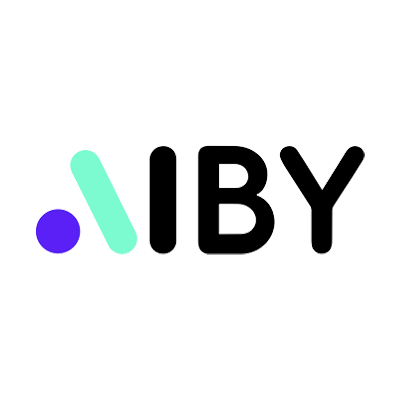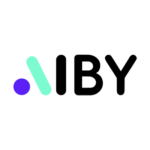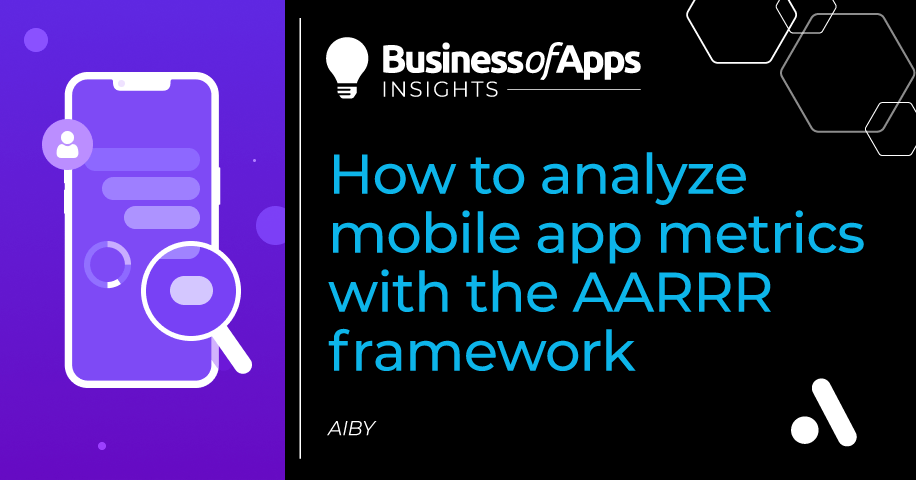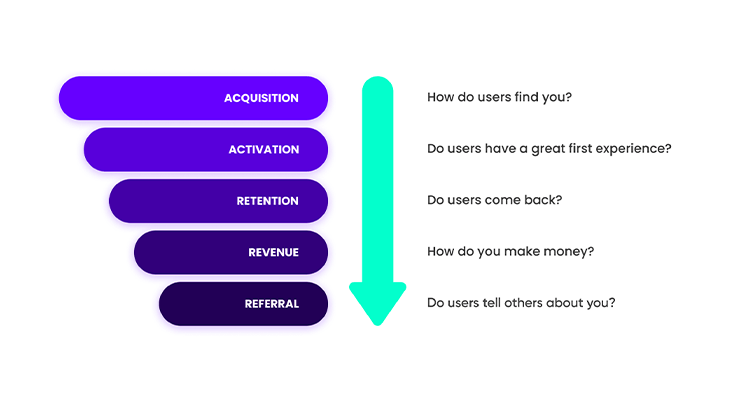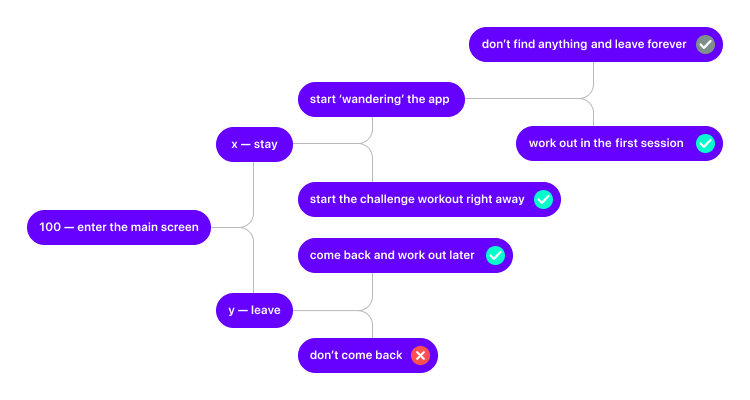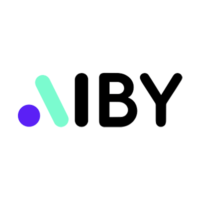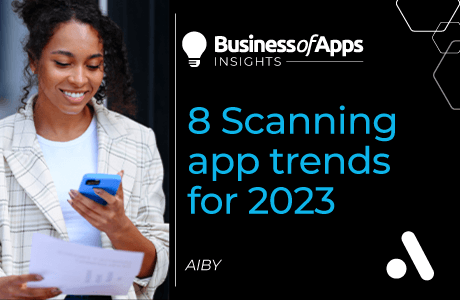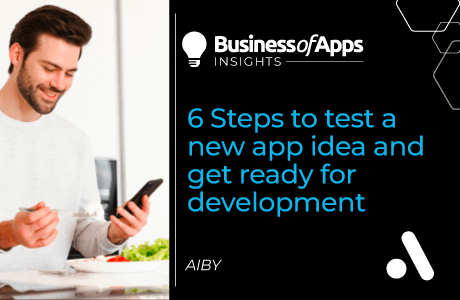It doesn’t matter what kind of product you develop or what the success criteria are. For some, the latter might be to figure out the unit economics. For others, they are to create a strong user community with a high retention rate. In any case, it’s important to understand whether you’re going in the right direction and what steps to take at different stages.
This guide is designed to help analyze app metrics. It will give you a clear insight of how to measure the success of customer acquisition and monetization by the AARRR framework (also called pirate metrics). It was prepared on the basis of our home workout planner app HitFit.
The AARRR framework
Source: Aiby
We match the metrics we need to analyze with appropriate funnel phases to understand what the focus should be.
Acquisition
This metric is the primary interest of marketing specialists, but there’s something product developers can learn from it too:
- Ad CTR – As the marketing team tests different ad concepts, there’s a great opportunity to understand what a product lacks and what the users are interested in based on the CTR.
- Store conversion – Look at the first promo screenshots in the store. Change the positions of the screenshots with different features to figure out which combination performs better. Monitor your competitors’ screenshots also.
Activation
Onboarding
Find the moment the users abandon the onboarding. It often indicates areas where they are experiencing problems. Perhaps you ask unnecessary or incorrect questions? For example, in fitness apps, it’s better to ask about target areas rather than problem zones. Remember that onboarding results should not be measured in terms of what % of the users finish it. Look at the conversion to purchase or activation in the first target action.
Build the user onboarding
You can do it with the help of Amplitude or Mixpanel. Pay attention to the steps the users take after the first target action. This is an excellent signpost for working on the features aimed at improving retention. In our product, we relied on the user actions after purchasing to understand whether we should have worked with a workout (activation) right then, or whether there were any bottlenecks.
Here’s an example:
Source: Aiby
In the first block, write 100 as the number of users. And then, also write the number of users in each branch. So, with the help of division, it’s possible to calculate the conversion percentage immediately.
Retention
Find and analyze your core feature—the one that keeps the users coming back to the app. This is neither a base feature nor a wow/a-ha/satisfier one. This feature should have a high level of both activation and retention. Otherwise, the high-retention feature you bet on might be only relevant to a small group of the most loyal users. In our fitness app, we identified the content that activates and retains the user best and are constantly working on it.
“Onboarding screens are one of the best places for A/B testing. Display a small feature demo on the onboarding screen and let the user interact with your product. If a feature is complex or takes a lot of time, it’s better to try other ways to communicate value. For example, giving a choice of favourite artists in a music app is a good practice. But forcing the user to complete a workout is not,” explained Dima Khritankov, VP of Product at AIBY Group.
To maintain interest, reward the user for the actions taken:
Payments are silently stalling startup growth
High fees. Failed payments. Single point of failure. Our report shows why payments are holding startups back and how to fix it.
Download The Report- Don’t give the game away at once. A good example of getting trophies is PlayStation or Xbox games, where the reward description exists but is hidden.
- Immediately involve the user in a series of actions, similar to the challenges in Apple Fitness+.
- Reward the user unexpectedly. But don’t make it an achievement system. Otherwise, the users who want to earn all the achievements will hate you because they won’t know what to do.
Create rewards according to the user’s value:
- Social rewards. These could be likes, views, and reactions.
- Hunting-gathering rewards. Here we can give out gems that open secret levels or puzzles by collecting which the user can reveal hidden knowledge.
- Personal rewards. They celebrate skills, competence, or a completed action. Use certificates and medals in this case.
“After the user gets a dopamine dose and expects the next reward, ask them to invest in your product. The investment usually takes the form of asking to provide a combination of time, data, extra effort, social capital, or money. The investments should make the user experience more interesting and valuable,” added Dima Khritankov.
Revenue
Revenue is in last place in the classic AARRR framework. But for most businesses, it seems more logical to place it above Referral. This step allows you to understand whether your efforts are bringing in a proper income. For a business model to work well, increase the Customer Lifetime Value (CLV or LTV) and decrease the Customer Acquisition Cost (CAC). A good LTV to CAC ratio should be at least 20%. The formula is (LTV-CAC)/CAC)*100%.
Using the subscription-based app monetization model on the Revenue step, pay attention to the following metrics:
- Subscription conversion rate – the higher the conversion, the cheaper the CAC is, and the more revenue we get.
- Subscription retention – if you offer a free trial subscription, it’s important to keep an eye on the trial conversion → first payment. Nothing shows how much the users like your product better than their willingness to pay after the trial period.
Referral
Referral is the act of turning your users into your ambassadors and, at the same time, it’s an amazing opportunity for the product to grow almost for free. Track of NPS to measure product satisfaction and the desire to share the product.
A Viral coefficient is another noteworthy metric. It is an indicator that shows the average number of users attracted to the app by one person. Not all products are viral; for example, messengers aren’t. But for almost every app, you can develop the means for product sharing:
- Refer a friend and get N days of Premium for free
- Gift certificates for your product
- Add watermarks with the app logo and name when the user shares images
Track referrals by using special links or “How did you find out about us” questions on the onboarding screen. The viral coefficient of two means that one person brings in 2 more users. To have exclusively organic growth, the viral coefficient must be higher than 1. In general, any referral program will help the product grow. App Store and Google Play reviews also can be considered referral metrics.
After the work is done, you will have a more thorough product knowledge. Put the insights and weaknesses you have found in the AARRR funnel again and answer the question of what you want to take on first. Focus on one area of the metric at a time. Of course, sometimes you need everything at once. In that case, make releases with different sets of metrics (for example, install-trial in one, trial-paid in another, and retention in the third).

